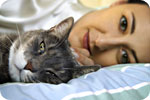
Essential Oils: The Hidden Dangers for Well-Meaning Animal Lovers
Sunday, March 30, 2008 by: Mel Possehl
Tags: pet health, essential oils, health news
- Criminal referral requests filed against Fauci and top COVID officials in seven states
- Aluminum, essential to vaccine science, also causes serious health conditions, including chronic fatigue, neurodegenerative diseases, macrophagic myofasciitis
- DOGE unveils $400M unemployment fraud scandal: Toddlers, futuristic birthdates fuel outcry
- Oats: A nutritional powerhouse for health and wellness
- Gardening tips: 15 Simple tricks to double your garden’s yield this season
- TAKE IT DOWN Act advances in Congress amid free speech concerns
- A turning point in American economic history: “The Origins of the Federal Reserve” by Murray N. Rothbard
- Nature’s arsenal: How plant compounds power military survival and healthcare in crisis
- Survival 101: Dangerous places to avoid when disaster strikes
- Kawasaki unveils rideable ROBOT HORSE powered by hydrogen
- Amazon's Kuiper satellite launch delay highlights uphill battle against Musk's Starlink
- DOJ and ATF kill Biden’s “Zero Tolerance” firearms dealer policy
- U.S.-funded "anti-misinformation" groups persist, raising concerns over censorship and bias
- Tesla halts U.S.-made Model S and X orders in China amid escalating trade war
- Trump to impose major tariffs on foreign-made pharmaceuticals
- “Prepare Tribe: Prepare, Protect, Provide” on BrightU: Protecting heirloom crops from corporate extinction
- Barley: A nutrient-dense ancient grain with modern benefits
- “Prepare Tribe: Prepare, Protect, Provide” on BrightU: How to build a disaster-proof shelter in the middle of nowhere
- Tulsi Gabbard leads charge against the Biden regime’s global censorship of the 'Disinformation Dozen'
- Fauci is back in the limelight, and he’s busy promoting a future COVID or FLU pandemic
- Aerosolized bioweapons? Strange “diploid biomasses” falling out of the sky in Florida captured under the microscope
- Analysis: The coming economic collapse, a mass uprising and Trump's three secret weapons to halt the growing revolt
- Widespread social and economic unrest: Steve Quayle issues urgent financial warning of imminent asset collapse in new interview with Mike Adams
- Kiss Your Genetic Privacy Good-Bye! 23andMe Gets Green Light to Sell Your Intimate Genetic Details to Anyone They Want
- Tulsi Gabbard takes aim at censorship: Justice for the ‘Disinformation Dozen’
- Mike Adams releases country western hit single: Goin’ Back in Time is Comin’ Home
- U.S. lawmakers investigate Meta over alleged China collaboration
- CLOT SHOT PLANDEMIC UNFOLDING: Fibrous, rubbery clots caused by covid injections have prion-like seeding activity
- Chemtrails unveiled: How the CIA and Big Business are manipulating the weather for profit
- How Israeli military-connected corporations are secretly controlling your online privacy
- European Court of Justice: Healthcare professionals who promoted or administered COVID-19 vaccines are CRIMINALLY LIABLE for any harm caused
- DEATH by VACCINE or face PRISON time: Canadian Freedom Convoy leaders CONVICTED for protesting forced vaccination during the Covid Plandemic
- Defunding DEADLY mRNA jabs: Government funding for mRNA technology being scrutinized and sidelined until proven "safe and effective" for real
- Federal employees whine over DOGE's new directive requiring them to do a 5-point summary of weekly accomplishments
- U.S. approves new Russian ambassador as diplomatic thaw continues
- Curcumin’s ancient healing power supercharges muscle recovery, and its effects are compounded with anti-inflammatory foods and supplements
- Newly released JFK files reveal Pentagon's role in creating Lyme disease and covid in the same lab
- Analysis: The coming economic collapse, a mass uprising and Trump's three secret weapons to halt the growing revolt
- Mike Adams releases country western hit single: Goin’ Back in Time is Comin’ Home
- Aerosolized bioweapons? Strange “diploid biomasses” falling out of the sky in Florida captured under the microscope
- Kiss Your Genetic Privacy Good-Bye! 23andMe Gets Green Light to Sell Your Intimate Genetic Details to Anyone They Want
- Dr. Mike Yeadon releases 15-minute testimony - WATCH - about genocidal intent of COVID “vaccines”
- Trump reverses course on Gaza plan, says “nobody is expelling Palestinians”
- MEDICAL BOMBSHELL: FDA admits Covid mRNA 'Vaccines' CAUSE CANCER
- European Court of Justice: Healthcare professionals who promoted or administered COVID-19 vaccines are CRIMINALLY LIABLE for any harm caused
- The Health Ranger releases “Vaccine Zombie” song and music video, using AI-animated zombies for the music video
- 5 Simple steps to boost your brainpower: How to strengthen executive function in a distracted world
- A lack of integrity in Academia: Harvard professor found GUILTY of fraudulent research to promote CRT theory
- Federal employees whine over DOGE's new directive requiring them to do a 5-point summary of weekly accomplishments
- EPA advisor admits the agency is funneling billions to climate groups ahead of Trump’s return to White House
- California's social media censorship law struck down: A victory for free speech or a threat to online safety?
- Space war brewing? Russia threatens to destroy Starlink satellites
- Survival 101: Effective EMF blocking techniques
- Rep. Nancy Mace introduces bill to ban biological males from female facilities on federal property
- Red Cross issues warning to stop blood plasma donations from vaccinated people
- Scientists confirm: GENIUS brain function can be spontaneously unleashed in humans without any apparent cause
- EPA advisor admits the agency is funneling billions to climate groups ahead of Trump’s return to White House
- HYSSOP: What research reveals about the health benefits of this ancient holy herb
- Two containers with completed ballots fall out of truck in Florida
- Newly released JFK files reveal Pentagon's role in creating Lyme disease and covid in the same lab
- Global leaders unite to clamp down on “misinformation” with UN-backed Cascais Declaration
- BREAKING: 2025 NDAA authorizes mandatory military draft of WOMEN across America… as Pentagon pursues global NUCLEAR war with both Russia and China at the same time
- Michael Yon warns of a ZIONIST TAKEOVER in Trump’s second administration
- Ozempic and Wegovy weight loss drugs are injectable LIZARD VENOM PEPTIDES that may unleash a devastating wave of organ failure… side effects align with symptoms of SNAKE BITES
- The Health Ranger releases “Vaccine Zombie” song and music video, using AI-animated zombies for the music video
- Mike Adams releases country western hit single: Goin’ Back in Time is Comin’ Home
- BOMBSHELL: DNA testing kits are a SCAM to develop ethnic-specific bioweapons
- Israeli soldiers accused of even more torture and abuse in the West Bank
- These 13 countries just signed an agreement to engineer a global FAMINE by destroying food supply
- NASA admits that climate change occurs because of changes in Earth’s solar orbit, and NOT because of SUVs and fossil fuels
- Fully vaccinated about to see “tsunami” of illness and death, warns virologist
- RFK Jr. clears key hurdle: Sen. Susan Collins backs controversial HHS nominee, signaling a new era for health policy
There have been many reports of animals harmed, even dying, from essential oils. Tea Tree Melaleuca alternifolia, has received a bad rap lately, most likely stemming from the fact that it is so widely available. Well meaning owners have used this oil to treat dermatological afflictions such as bites and scratches, only to end up at the veterinarian's office with an animal exhibiting signs of toxicity, such as ataxia, in-coordination, weakness, tremors, vomiting or depression.
Misinformation is an enormous problem in this area as well. As an increasing amount of people turn to a more natural approach at life, companies are jumping to cash in. Thousands of products include essential oils in their ingredients; pet products are no different. The average person, unaware of the dangers, can easily think these products would be completely safe when in fact they are not.
Pennyroyal (Hedeoma pulegioides), for instance, is widely used as flea control. This oil is a known abortifacient in humans, and considered a toxin to the liver and the kidneys. Not exactly a strong selling point, although it is very good at keeping fleas at bay!
Many products for cats also contain essential oils. Unfortunately for the cats, many cat owners are unaware that by using these products, they can slowly cause toxins to build up in the feline's system, causing a slow onset of organ failure. A cat's liver cannot process toxins as a human's or even a dog's can, and the chemical constituents of the oils, such as terpenes, phenols, and ketones, are no exception. The effects of these can be immediate in showing up, or can take years.
Birds are well known for being sensitive to scents and particles in the air, and essential oils are no different. Gillian Willis, a toxicologist in Vancouver, has seen many cases of avian poisoning, including a well-meaning cockatiel owner who, upon seeing an abrasion on her bird's foot, applied a drop of Tea Tree oil. The bird became depressed and even with veterinary intervention, died within 24 hours of respiratory failure. Even diffusing oils around a bird can produce dire consequences.
Not All Is Lost
While this may all seem daunting to an animal lover who also enjoys the benefits of aromatics, all is certainly not lost. A little knowledge can go a long way while incorporating essential oils in and around your animals.
Choosing Essential Oils:
Purity can be an issue when it comes to essential oils (EO's). For example, it takes approximately one hundred pounds of plant material to produce one pound of Lavender Lavandula angustifolia. Due to the expense, many essential oils are diluted in other substances. These can range from carrier oils, such as Jojoba, to synthetic fragrance, even chemicals. When you are choosing essential oils to use therapeutically for yourself and your pets, you want only the purest available. To determine this, there are a few key things to look for:
* EO's should not be oily or leave a greasy residue.
* Packaging should include the common name (Lavender), the Latin binomial (Lavandula angustifolia), the country of origin, the method of distillation, the part of the plant used, lot number, amount of oil in bottle, contact information of the company, how the plant was grown, and the words "100% pure essential oil" or the ingredients, if in a carrier or blend.
* Price usually dictates quality.
* Not all bottles of the same size yet of different oils should be priced the same. In other words, if they carry 50 different types of oils, yet every 5ml bottle is $7.40, there is something wrong, and you can guarantee these oils have been adulterated in some way.
Using Quality Oils in Homes With Pets:
Once you have your essential oils and are satisfied with the quality, the task then becomes using them correctly. While they can be very therapeutic and helpful, they can also do harm. Remember, just because a product is natural, does not mean it is safe.
There are some essential oils that should never be used for animals: Anise, Clove Leaf/Bud, Garlic, Horseradish, Juniper, Thyme, Wintergreen, or Yarrow, to name a few.
Some that can be used include: Cedarwood Atlas, Chamomile, Eucalyptus, Ginger, Lavender, Myrrh, Ravensare, Rose, and Valerian (note that these lists are not exhaustive and further research from the pet owner should be done).
For dogs, essential oils can be used in a variety of ways, from bathing to calming the nerves through diffusion. Some points to remember:
* Dogs cannot tell you what is or is not working. As such, you must closely watch their reactions. Excessive scratching, sniffing, nervousness or whining are all signs to watch for.
* Always dilute the oils. A common acceptable dilution is 25% of the adult human formula.
* Giving essential oils internally is not generally recommended.
* Do not use any oils on medium-large breed puppies under 8 weeks, and small or toy breeds under 10 weeks. Hydrosols are a much better choice.
* Gradually introduce the oils.
* What is good for a large dog is not good for a small dog. Size matters, and less is definitely more when working with oils, for animals or humans.
* Sick, frail, older, or pregnant dogs have special considerations, just as in humans. Do not administer the same dose to them as you would to a healthy animal of the same size.
* Never use oils near the eyes, mouth, nose, or genital area.
Felines are especially sensitive, as previously mentioned. Even dispersing oils in the air or using them as cleaning agents around the house can be detrimental. Make sure that the cat has a way to go into another room, with fresh air to 'escape'. Oils should never be used topically because of their liver's inability to process them. Hydrosols, also known as hydrolats or floral water, are a much safer option with many of the same benefits. For smaller animals, such as hamsters, guinea pigs, and rabbits, hydrosols are also the best option, at a 50% dilution of what is used for felines.
Birds should never be exposed to oils, whether topically or in the air due to their extreme sensitivity. Hydrosols can be used, but in very minute amounts, much like in homeopathic remedies.
Fish cannot tolerate oils or floral waters. The oils, not being water-soluble, would end up sticking to the fish, causing a host of problems, up to and many times, including death. Hydrosols each have their own pH levels, and have the possibility of wreaking havoc on the pH levels within the tank, also causing harm to the fish.
An animal lover's best bet, for the sake of their pet, would be to educate themselves even further. One must be cautioned about searching the net, however, as misinformation is everywhere. Be sure to check the credentials of the writer before following the advice of any site. There are a few good books on the subject, one of my favorites, and the reference for this article, is Holistic Aromatherapy for Animals by Kristen Leigh Bell.
Remember, with a little love and research, aromatherapy can be highly beneficial to humans and animals alike!
Reference:
Bell, Kristen. Holistic Aromatherapy for Animals. Findhorn-Forres, Scotland: Findhorn Press, 2002.
About the author
Mel Possehl is a Holistic Wellness Consultant working towards dual diplomas in Herbalism & Holistic Health, and enjoyed a year long certification course in Aromatherapy.When she isn't busy finding new ways to incorporate natural products into her family's lives, she enjoys things like reading global warming articles and finding great Western Caribbean cruise deals.
Pet health at FETCH.news
Get independent news alerts on natural cures, food lab tests, cannabis medicine, science, robotics, drones, privacy and more.
Take Action: Support Natural News by linking to this article from your website
Permalink to this article:
Embed article link: (copy HTML code below):
Reprinting this article:
Non-commercial use OK, cite NaturalNews.com with clickable link.
Follow Natural News on Facebook, Twitter, Google Plus, and Pinterest
Science News & Studies
Medicine News and Information
Food News & Studies
Health News & Studies
Herbs News & Information
Pollution News & Studies
Cancer News & Studies
Climate News & Studies
Survival News & Information
Gear News & Information
News covering technology, stocks, hackers, and more



"Big Tech and mainstream media are constantly trying to silence the independent voices that dare to bring you the truth about toxic food ingredients, dangerous medications and the failed, fraudulent science of the profit-driven medical establishment.
Email is one of the best ways to make sure you stay informed, without the censorship of the tech giants (Google, Apple, Facebook, Twitter, YouTube, etc.). Stay informed and you'll even likely learn information that may help save your own life."
–The Health Ranger, Mike Adams












































